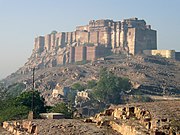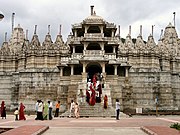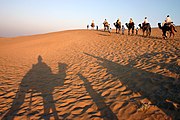rajasthan
![]()
Rājasthān(राजस्थान, pronounced [raːdʒəsˈtʰaːn] ) is the largest state of the Republic of India in terms of area. It encompasses most of the area of the large, inhospitable Great Indian Desert (Thar Desert), which has an edge paralleling the Sutlej-Indus river valley along its border with Pakistan. The state borders PakistanGujarat to the southwest, Madhya Pradesh to the southeast, Uttar Pradesh and Haryana to the northeast and Punjab to the north. Rajasthan covers an area of 132,150 sq mi or 342,269 km². to the west,
The state capital is Jaipur. Geographical features include the Thar Desert along north-western Rajasthan and the termination of the Ghaggar River near the archaeological ruins at Kalibanga, which are the oldest in the subcontinent discovered so far.
One of the world's oldest mountain ranges, the Aravalli Range, cradles the only hill station of Rajasthan, Mount Abu, and its world-famous Dilwara Temples, a sacred pilgrimage for Jains. Eastern Rajasthan has two national tiger reserves, Ranthambore and Sariska, as well as Keoladeo National Park near Bharatpur, once famous for its bird life.
Rajasthan was formed on 30 March 1949, when all erstwhile princely states ruled by Rajputs, known as Rajputana, merged into the Dominion of India. The only difference between erstwhile Rajputana and Rajasthan is that certain portions of what had been British India, in the former province of Ajmer-Merwara, were included. Portions lying geographically outside of Rajputana such as the Sumel-Tappa area were given to Madhya Pradesh.
History
The Indus Valley Civilization, one of the world's first and oldest civilizations, was located in part of what is now Rajasthan. Kalibangan in Hanumangarh district, Rajasthan was a major provincial capital of the Indus Valley Civilization. Traditionally the Rajputs, Yadavs, Jats, Bhils, Gujars, Meenas and other tribes made a great contribution in building the state of Rajasthan. All these tribes suffered great difficulties to protect their culture and the land. Millions of them were martyred for this land. ‘The Hinduan Suraj’ title to Udaipur was only due to Sisodia Rajputs. Gujars had been exterminated in Bhinmal and Ajmer areas fighting with the invaders. Bhils once ruled Kota and Bundi. Bargujars were sardars in Alwar, Jodhpur and Ajmer areas. Bargujars and Meenas were ruler of Dhundhar region, Bundi.



The earlier contributions of warriors and protectors of the land — Bargujars, Jats, Bhils, Gujars and Meenas — were neglected and lost in history. Rajasthan means the Land of the Kings. Modern Rajasthan includes most of Rajputana, which comprises mainly the erstwhile Rajput kingdoms as well as two Jat kingdoms and a Muslim kingdom.Jodhpur, Bikaner, Udaipur, and Jaipur were some of the main Rajput states. The Jats were rulers in Bharatpur and Dholpur. Tonk was ruled by a Muslim Nawab .Rajput families rose to prominence in the 6th century CE. The Rajputs put a very valiant resistance to the Islamic invasions and protected this land with their warfare and chivalry for more than 500 years.They also resisted Mughal incursions into India, but contributed to the slower than anticipated access to the Indian Subcontinent. Later The Mughals ,with a technique based on the combination of treachery and skilled warfare were able to set firm grip on northern India. The fighter spirit and valour of Rajputs impressed the Mughals to such an extent that they started treating their Rajput aides as the backbone of their Kingdom.Even after defeating, the Mughals took Rajput valour and value in highest esteem.
Mewar led others in resistance to Muslim rule: Rana Sanga fought the Battle of Khanua against Babur, the founder of the Mughal empire; and Maharana Pratap Singh resisted Akbar in Haldighati, the Bhils were Rana's main allies. Most of these attacks were evenly met as the Mughals outnumbered Rajputs in great numbers in all the wars fought between them.The Haldighati war was fought between 10,000 Rajputs and 1,00,000 Mughal force. Over the years the Mughals began to have internal disputes which took their concentration away at times. They also had to fight off Pathan warriors from neighbouring Afganistan and the newer enemy, the British Empire which consisted of large numbers of natives whilst engaging against various other regional powers such as the persians. The Mughal Empire eventually weakened to which several groups across their kingdom (including sikhs) saw opportunities to establish their power whilst the army was fighting somewhere else. The Rajputs saw this as an opportunity to reassert their independence. With the decline of the Mughal Empire in the 18th century, RajputanaMarathas and Pindaris, and the Maratha general Scindia captured Ajmer. The Rajput kings following a rapid defeat, concluded treaties with the British in the early 19th century, accepting British sovereignty in return for local autonomy. Following the Mughal tradition as well as its strategic location Ajmer became a province of British India, while the autonomous Rajput states, the Muslim state Tonk, and the Jat states (Bharatpur and Dholpur) were organized into the Rajputana Agency. came under attack by the
The Marwaris (people from Marwar) and Rajasthan's formerly independent kingdoms created a rich architectural and cultural heritage, seen today in their numerous forts and palaces (Mahals and Havelis) which are enriched by features of Muslim and Jain architecture. The development of the frescos in Rajasthan is linked with the history of the Marwaris, who have also played a crucial role in the economic development of the region. Most of the wealthiest families throughout Indian history have links to Marwar. These families include the legendary Birla, Bhandari, Bajaj, Mittal,Agrawal and Khandelwal families.
Geography
The main geographic features of Rajasthan are the Thar Desert and the Aravalli Range, which runs through the state from southwest to northeast, almost from one end to the other, for more than 850 km. Mount Abu is at the southwestern end of the range, separated from the main ranges by the West Banas River, although a series of broken ridges continues into Haryana in the direction of Delhi where it can be seen as outcrops in the form of the Raisina Hill and the ridges farther north. About three-fifths of Rajasthan lies northwest of the Aravallis, leaving two-fifths on the east and south.
The northwestern portion of Rajasthan is generally sandy and dry. Most of the region is covered by the Thar Desert, which extends into adjoining portions of Pakistan. The Aravalli Range does not intercept the moisture-giving southwest monsoon winds off the Arabian Sea,as it lies in a direction parallel to that of the coming monsoon winds, leaving the northwestern region in a rain shadow. The Thar Desert is thinly populated; the town of Bikaner is the largest city in the desert. The Northwestern thorn scrub forests lie in a band around the Thar Desert, between the desert and the Aravallis. This region receives less than 400 mm of rain in an average year. Summer temperatures can exceed 45 °C in the summer months and drop below freezing in the winter. The Godwar, Marwar, and Shekhawati regions lie in the thorn scrub forest zone, along with the city of Jodhpur. The Luni River and its tributaries are the major river system of Godwar and Marwar regions, draining the western slopes of the Aravallis and emptying southwest into the great Rann of Kutch wetland in neighboring Gujarat. This river is saline in the lower reaches and remains potable only up to Balotara in Barmer district. The Ghaggar River, which originates in Haryana, is an intermittent stream that disappears into the sands of the Thar Desert in the northern corner of the state and is seen as a remnant of the primitive Saraswati river.
The Aravalli Range and the lands to the east and southeast of the range are generally more fertile and better watered. This region is home to the Kathiarbar-Gir dry deciduous forests ecoregion, with tropical dry broadleaf forests that include teak, Acacia, and other trees. The hilly Vagad region lies in southernmost Rajasthan, on the border with Gujarat. With the exception of Mount Abu, Vagad is the wettest region in Rajasthan, and the most heavily forested. North of Vagad lies the Mewar region, home to the cities of Udaipur and Chittaurgarh. The Hadoti region lies to the southeast, on the border with Madhya Pradesh. North of Hadoti and Mewar is the Dhundhar region, home to the state capital of Jaipur. Mewat, the easternmost region of Rajasthan, borders Haryana and Uttar Pradesh. Eastern and southeastern Rajasthan is drained by the Banas and Chambal rivers, tributaries of the Ganges.
The Aravali Range runs across the state from the southwest peak Guru Shikhar (Mount Abu), which is 1,722 m in height, to Khetri in the northeast. This divides the state into 60% in the northwest of the range and 40% in the southeast. The northwest tract is sandy and unproductive with little water but improves gradually from desert land in the far west and northwest to comparatively fertile and habitable land towards the east. The area includes the Thar Desert. The south-eastern area, higher in elevation (100 to 350 m above sea level) and more fertile, has a very diversified topography. in the south lies the hilly tract of Mewar. In the southeast, a large area within the districts of Kota and Bundi forms a tableland. To the northeast of these districts is a rugged region (badlands) following the line of the Chambal River. Farther north the country levels out; the flat plains of the northeastern Bharatpur district are part of an alluvial basin.



Tourism
Endowed with natural beauty and a great history, tourism is a flourishing industry in Rajasthan. The palaces of Jaipur, lakes of Udaipur, and desert forts of Jodhpur, Bikaner & Jaisalmer are among the most preferred destination of many tourists, Indian and foreign. Tourism accounts for eight percent of the state's domestic product. Many old and neglected palaces and forts have been converted into heritage hotels. Tourism has increased employment in the hospitality sector.
Rajasthan is famous for the majestic forts, intricately carved temples and decorated havelis, which were built by Bargujar kings in previous ages, they were the soul of pre-Muslim era Rajasthan. Jantar Mantar, Dilwara Temples, Chittorgarh Fort, Lake Palace, City Palaces, Jaisalmer Havelis are part of the true architectural heritage of India. Jaipur, the Pink City, is noted for the ancient houses made of a type of sand stone dominated by a pink hue. At Ajmer, the white marble Bara-dari on the Anasagar lake is exquisite. Jain Temples dot Rajasthan from north to south and east to west. Dilwara Temples of Mount Abu, Ranakpur TempleUdaipur, Jain temples in the fort complexes of Chittor, Jaisalmer and Kumbhalgarh, Lodarva Jain temples, Bhandasar Temple of Bikaner are some of the b dedicated to Lord Adinath near est examples.
Rajasthan is often called a shopper's paradise. Rajasthan is famous for textiles, semi-precious stones and handicrafts. The attractive designs of jewellery and clothes are eye-catching and invite shoppers. Rajasthani furniture has intricate carvings and bright colours. Rajasthani handicrafts are in demand due to the intricate work on them. Above all, Rajasthan's shopping appeals to both tourists and people from other parts of India due to its cheap prices for quality goods.


Culture
Rajasthan is culturally rich and has artistic and cultural traditions which reflect the ancient Indian way of life. There is rich and varied folk culture from villages which is often depicted symbolic of the state. Highly cultivated classical music and dance with its own distinct style is part of the cultural tradition of Rajasthan. The music is uncomplicated and songs depict day-to-day relationships and chores, more often focused around fetching water from wells or ponds.
The Ghoomar dance from Udaipur and Kalbeliya dance of Jaisalmer have gained international recognition. Folk music is a vital part of Rajasthani culture. Kathputali, Bhopa, Chang, Teratali, Ghindar, Kachchhighori, Tejaji etc. are the examples of the traditional Rajasthani culture. Folk songs are commonly ballads which relate heroic deeds and love stories; and religious or devotional songs known as bhajans and banis (often accompanied by musical instruments like dholak, sitar, sarangi etc.) are also sung.
Rajasthan is known for its traditional, colorful art. The block prints, tie and dye prints, Bagaru prints, Sanganer prints, Zari embroidery are major export products from Rajasthan. Handicraft items like wooden furniture and handicrafts, carpets, blue pottery are some of the things commonly found here. Rajasthan is a shoppers' paradise, with beautiful goods found at low prices. Reflecting the colorful Rajasthani culture, Rajasthani clothes have a lot of mirror-work and embroidery. A Rajasthani traditional dress for females comprises an ankle length skirt and a short top, also known as a lehenga or a chaniya choli. A piece of cloth is used to cover the head, both for protection from heat and maintenance of modesty. Rajasthani dresses are usually designed in bright colours like blue, yellow and orange.
The main religious festivals are Eid Deepawali, Holi, Gangaur, Teej, Gogaji, Makar Sankranti and Janmashtami, as the main religion is Hinduism. Rajasthan's desert festival is celebrated with great zest and zeal. This festival is held once a year during winters. Dressed in brilliantly hued costumes, the people of the desert dance and sing haunting ballads of valor, romance and tragedy. There are fairs with snake charmers, puppeteers, acrobats and folk performers. Camels, of course, play a stellar role in this festival.




